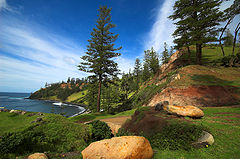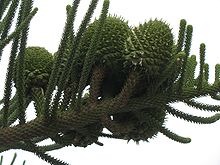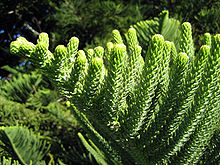- Araucaria heterophylla
-
Araucaria heterophylla 
Norfolk Island Pines, Norfolk Island Conservation status Scientific classification Kingdom: Plantae Division: Pinophyta Class: Pinopsida Order: Pinales Family: Araucariaceae Genus: Araucaria Species: A. heterophylla Binomial name Araucaria heterophylla
(Salisb.) FrancoAraucaria heterophylla (synonym A. excelsa) is a distinctive conifer, a member of the ancient and now disjointly distributed family Araucariaceae. As its vernacular name Norfolk Island Pine implies, the tree is endemic to Norfolk Island, a small island in the Pacific Ocean between Australia, New Zealand and New Caledonia. The genus Araucaria occurs across the South Pacific, especially concentrated in New Caledonia (about 700 km due north of Norfolk Island) where 13 closely related and similar-appearing species are found. It is sometimes called a 'star pine', due to its symmetrical shape as a sapling, although it is not a true pine.
Contents
Morphology
The trees grow to a height of 50–65 m, with straight vertical trunks and symmetrical branches, even in the face of incessant onshore winds that can contort most other species.
The leaves are awl-shaped, 1-1.5 cm long, about 1 mm thick at the base on young trees, and incurved, 5–10 mm long and variably 2–4 mm broad on older trees. The thickest, scale-like leaves on coning branches are in the upper crown. The cones are squat globose, 10–12 cm long and 12–14 cm diameter, and take about 18 months to mature. They disintegrate at maturity to release the nut-like edible seeds.
The scientific name heterophylla ("different leaves") derives from the variation in the leaves between young and adult plants.
Uses
The first European known to have sighted Norfolk Island, and thus the Norfolk Island pine, Captain James Cook, in 1774, on his second voyage to the South Pacific on HMS Resolution. He named the island after the Duchess of Norfolk, wife of Edward Howard, 9th Duke of Norfolk (1685–1777). The Duchess was dead at the time of the island's sighting by Cook, but Cook had set out from England in 1772 and could not have known of her May 1773 death. Cook landed on Norfolk Island, and reported on the presence of large quantities of tall, straight trees which appeared to be suitable for use as masts and yards for sailing ships. However, when the island was occupied in 1788 by transported convicts from Britain, it was found that Norfolk Island Pine was not resilient enough for these uses and the industry was abandoned.[1]
In the late 1950s a trial shipment of Norfolk Pine logs was sent to Sydney plywood manufacturers in the hope of developing a timber export industry for the Island. Although the plywood companies reported excellent results the industry was deemed not sustainable by the Norfolk Island Advisory Council who decided to reserve local timber production for use on the Island. The timber is good for woodturning, and is extensively used by Hawaiian craftspeople.
Cultivation
The distinctive appearance of this tree, with its widely spaced branches and symmetrical, triangular outline, has made it a popular cultivated species, either as a single tree or in avenues. When the tree reaches maturity, the shape may become less symmetrical. As well as in its native Norfolk Island, it is widely planted in Australia, New Zealand, southern Florida, coastal California, south Texas, Hawaii, coastal Chile, Honduras, South Africa and some cities of Brazil. Many of the "Norfolk Island pines" growing in Hawaii, including their descendents growing as potted ornamentals on the U.S. mainland, are actually Cook Island pines, the two species having been confused when introduced.
It grows well in deep sand, as long as it receives reliable water when young. This, and its tolerance of salt and wind, makes it ideal for coastal situations.
Young trees are often grown as houseplants in areas where the winters are too cold for them to grow outside (they will not, for example, survive outdoors in most of the United States or Europe), and are sometimes used as Christmas trees. It will not survive in areas subject to prolonged cold. Large numbers of Norfolk Island Pines are produced in South Florida for the houseplant industry. The bulk of these are shipped to grocery stores, discount retailers and garden centers during November. Many of these are sprayed with a light coating of green paint prior to sale to increase their eye appeal.
Even in Florida, these trees are subject to frost damage and produce multiple stems with weakly attached trunks - in the 2004 hurricane season, many of these trees failed under the 160 km/h winds. As a result some coastal communities (e.g. Vero Beach) prohibit their use as a tree in local landscape plan approvals because of the danger posed by falling trunks.
Some people may experience a strong allergic reaction if they touch the leaves.
References and external links
- Conifer Specialist Group (1998). Araucaria heterophylla. 2006. IUCN Red List of Threatened Species. IUCN 2006. www.iucnredlist.org. Retrieved on 11 May 2006. Listed as Vulnerable (VU B1+2c v2.3)
- Gymnosperm Database: Araucaria heterophylla
References
- ^ The Fatal Shore. The epic of Australia's founding, Robert Hughes, 1987, Harvill Press, ISBN 0-394-75366-6
Categories:- IUCN Red List vulnerable species
- Araucaria
- Flora of Norfolk Island
- Pinales of Australia
- Vulnerable flora of Australia
Wikimedia Foundation. 2010.




